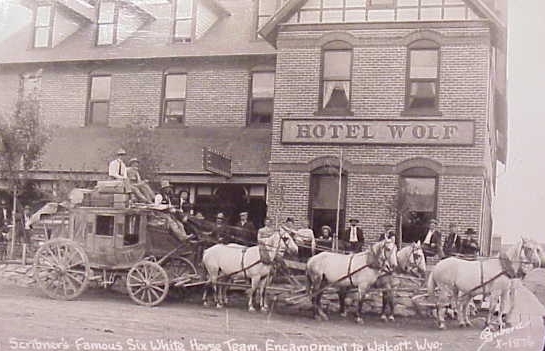
Walcott to Encampment Stage
in front of Wolf Hotel, Saratoga, Wyo.
For discussion and photos of Saratoga and the Wolf Hotel,
see N. Platte Valley.
As noted on the bottom of the photo, the Scribner
Stage Line ran from Walcott, via Saratoga, to Encampment. One of its more colorful
drivers was John Jefferson "G-String Jack" Fulkerson (1860-1947) who arrived in
Saratoga in 1902 from Pueblo where he had driven stages and freight wagons. When the railroad was under
construction, he served as the stable boss for the grading contractor.
Fulkerson apparently received his nick name from his skill at driving the 24-horse
teams required to pull the giant freighters which brought the equipment and
other gear into Encampment prior to the coming of the railroad.
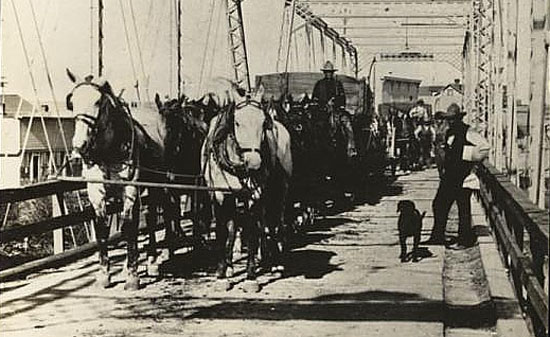
"G-String Jack" Fulkerson driving an eight-horse jerk-line rig across the
Saratoga Bridge, 1906.
A "G-string," more commonly referred to as
a "jerk line," is used to guide or steer the front left horse or mule
known as the "leader." The G-string or jerk line was connected to the
outside bit ring of the leader's bridle. In this manner, the whole team would be guided to the left or the right by a steady
pull or a succession of of jerks. The left horse or
mule of the lead span would then be connected to the right lead horse or mule by a
jockey stick (the stick in the photo beneath the leaders' heads) so that the right leader would be guided in the same direction as the left leader.
Behind the lead team would be the "swings." Each pair of horses, a "span," in a team would be numbered; that is in a sixteen horse team, the
second span would be the "fourteens," the team behind it the "twelves," and so forth back to
the next-to-the last span known as the "pointers" and the last span known as the "wheelers." While the lead span steered the team,
the pointers and the wheelers steered the lead wagon. Frequently, the driver or "skinner" rather than
riding on the lead wagon, would, as is
Fulkerson in the photo, ride the left wheel horse which would be saddled.
It has been speculated that the practice in the Americas of driving on the right-hand side of a highway was derived
from early freighters riding or walking beside the left wheel horse. By walking or driving on the left side, the
freighter could hold the jerk line, or in the case of oxen hold the bull whip, and operate
the brake on the left side of the vehicle with his right hand. Keeping the wagons to the right-side of the road assisted
in passing on-coming wagons. Thus, by the Civil War, it was the uniform practice in the United States, as opposed to our
British cousins, to
ride on the right-hand side of a road. Early motor cars in the United States had the steering
wheel on the curb side, but were soon moved to the left side. In a sense, therefore, while barrelling down
I-80, one is still guiding the left wheel horse.
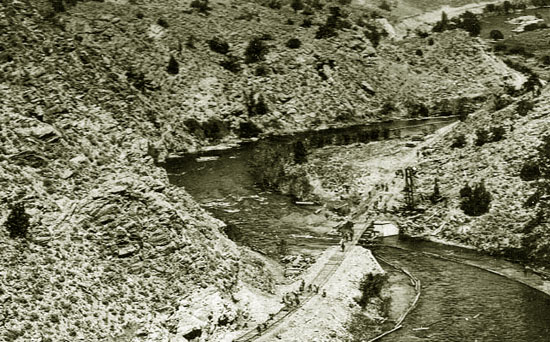
Railroad Construction, 1907.
As previously noted the railroad arrived in 1908. For Discussion and additional photographs of the Saratoga &
Encampment RailWay see Saratoga.
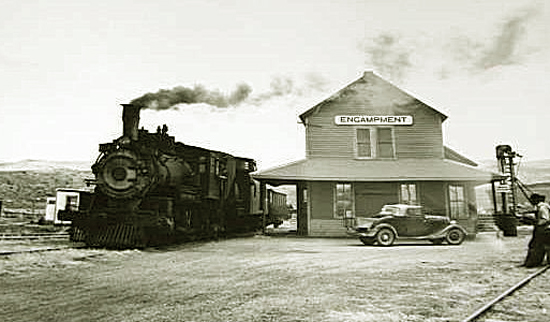
Railway Depot, Encampment, approx. 1930.
The depot depicted is a later depot which replaced the original which burned down in 1912.
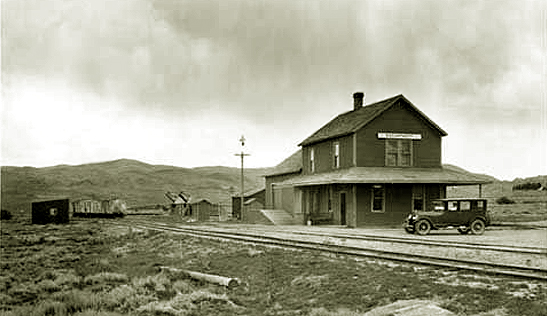
Railway Depot, Encampment, approx. 1930.
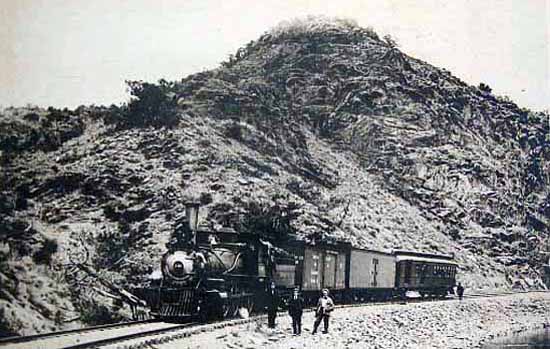
Locomotive 101, Saratoga & Encampment Railway, undated.
Operational control of the railroad was assumed under a lease by the Union Pacific
in 1921. the Union Pacific entered into the lease since it was not sure that the railroad was
financially viable. Formal ownership was assumed by the Union Pacific in 1928.
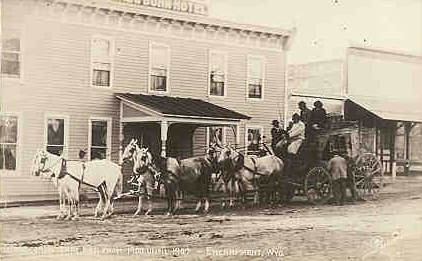
The Walcott, Saratoga and Encampment Stage in front of
the New Bohn Hotel, 1907
At the time, there were two hotels in town, Mrs. A. B. Kinsella's Copper State Hotel and the New Bohn.
The New Bohn hotel was operated by Miss Mary A. Bohn.
Miss Bohn came to Encampment from Cripple Creek where she had operated the Bohn House restuarant.
In Encampment, Mrs Bohn initially operated a small hotel and restauant the Bohn Hotel on Freeman
Street. In 1901, she constructed the "New Bohn Hotel. The old Bohn Hotel became the Plummer Cafe and much later it
housed the Echo newspaper.
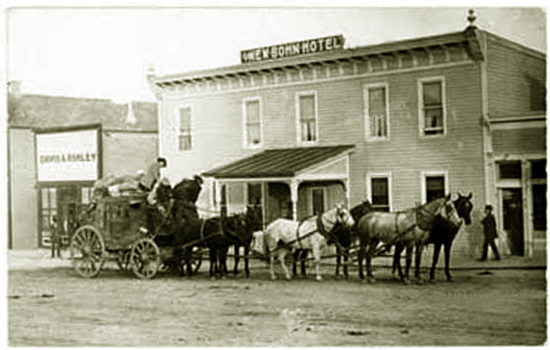
Another view of the Walcott, Saratoga and Encampment Stage in front of
the New Bohn Hotel, approx. 1902.
The small building to the left of the hotel is Davis & Ashley real estate and insurance agents. H. D. Ashley
was a city councilman.
The New Bohn featured steam heat and electric lights and advertised
a bar and billards. In the bar she served the "famous Goodhart-Hartman Company's" pure rye.
She served as Worthy Matron of the Encampment chapter of the Order of the Eastern Star.
On April 10, 1920, Miss Bohn was installed as part of the initial class of members of the Rebekahs, a part of the
Odd Fellows. In early May, Miss Bohn commenced the annual spring cleaning of the hotel but on
May 13, the Enchampment Echo reported that she was on the sick list. Two week later, after apparent improvement, she
died from "typhoid-pneumonia."
The funeral service, the largest ever held up to that time in Encampment, was conducted in the Town Hall by the
Eastern Star. Wreaths were provided by the Eastern Star, the Masonic Lodge, the Rebekahs and the Odd Fellows.
As a part of the service, Carleton Ashley sang Miss Bohn's favorite hymn, "Beatiful Isle of Somewhere." In 1911, Carl
sang at New York's Carnegie Hall. The hymn had become popular as a result of Harold Jarvis' 1909 Victor Talking Machine Company recording, played as the background
for this page. Miss Bohn's brother H. O. Bohn took her body back to Warm Springs, Montana, where she was interred. In 1927, Jack
Fulkerson purchased the hotel.
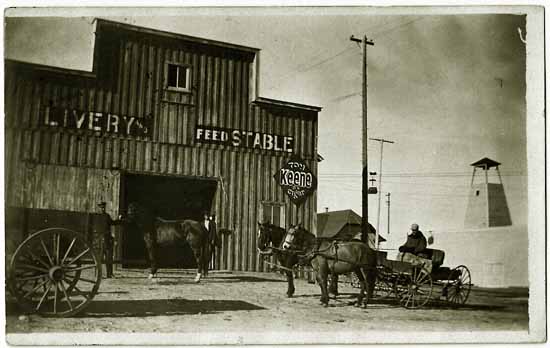
Livery Barn, Encampment approx. 1910.
The principal livery barn was that of J. G. Rankin on Rankin Avenue. The tower in the background is
the fire bell on the Town Hall. The "Tom Keene" sign on the building advertises a cheap cigar.
At the time a box of 50 Tom Keenes would sell for as little as $1.49. Eight cigars could go for as
little as 8 for twenty-five cents. It has been speculated that "B" western movie cowboy George Duryea adopted the
name Tom Keene after the cigar.
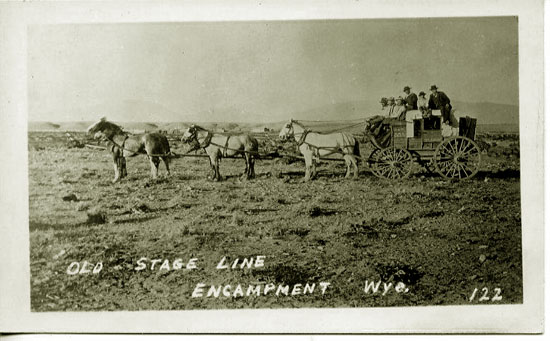
Walcott, Saratoga and Encampment Stage.
Today, the slightly less than 50 miles trip from Walcott to Encampment may take less than an hour with slight pauses for
Saratoga and Riverside. On the stage, the trip took from 7:00 a.m. to 4:30 p.m. with a lunch stop at
Saratoga. The stage, according to Winter, was facitiously referred to as the "Overland Limited," except when late when it was referred to as the
"Overdue Limited." At approximately noon the stage came to
Saratoga and would cross the Platte which then ran east and parallel
to the wagon road over which the stage travelled. Beyond the river lay the Medicine Bows. Various mountains came into view.
Most impressive was one referred to by Winter as "Old Baldy, so called because of his head, which was made up of white marble
or granite and rose high and bare above the timber line. Snow would give it a shining appearance and was thus, according to Winter,
referred to by early ranchers as "Gloss Mountain." Later promoters interested in selling stock in mining and railroad
opportunities renamed it "Gold Hill." It was originally going to be a destination of the Laramie, Hahns Peak and Pacific.
After leaving Saratoga, the Sierra Madres came into view. The stage passed Pass Creek, Spring Creek and Cow Creek. On distant slopes, great flocks of sheep could be observed.
After Encampment faded and failed, Walcott became for a brief time a center for sheep. Finally,
the stage rumbled into Encampment with the driver making a show of it. As Willis Emerson in his
Treasure of Hidden Valley observed:
If it is the invariable habit of stage drivers at the point of departure to start off their
horses in a full swinging gallop, it is an equally inviolable rule, when they approach the
point of arrival, that they come in with a whoop and a hooray. These laws are just as
immutable as ringing the bell or blowing the locomotive whistle when leaving or nearing a
station.
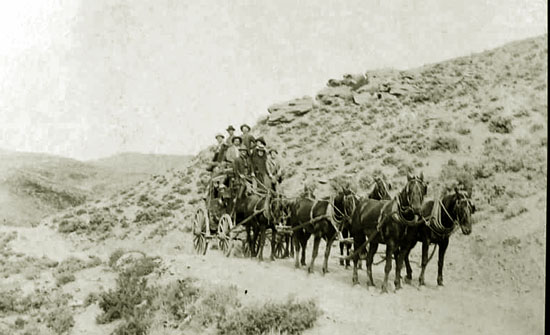
Walcott, Saratoga and Encampment Stage.
Music this page:
BEAUTIFUL ISLE OF SOMEWHERE
Composer, Jessie B. Pounds
Lyrics, John Sylvester Fearis
As sung by Harold Jarvis for the
Victor Talking Machine Company, 1909
Somewhere the sun is shining,
Somewhere the songbirds dwell;
Hush, then, thy sad repining,
God lives, and all is well.
Refrain
Somewhere, somewhere,
Beautiful Isle of Somewhere!
Land of the true, where we live anew,
Beautiful Isle of Somewhere!
Somewhere the day is longer,
Somewhere the task is done;
Somewhere the heart is stronger,
Somewhere the guerdon won.
Refrain
Somewhere the load is lifted,
Close by an open door;
Somewhere the clouds are rifted,
Somewhere the angels sing.
Refrain
Next page, Encampment continued.
|